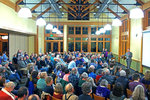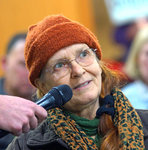U.S. Representative Derek Kilmer was largely met with community consternation over Navy plans Friday evening, Jan. 16 when more than 150 people packed the Fort Worden Commons for a town hall …
This item is available in full to subscribers.
We have recently launched a new and improved website. To continue reading, you will need to either log into your subscriber account, or purchase a new subscription.
If you had an active account on our previous website, then you have an account here. Simply reset your password to regain access to your account.
If you did not have an account on our previous website, but are a current print subscriber, click here to set up your website account.
Otherwise, click here to view your options for subscribing.
* Having trouble? Call our circulation department at 360-385-2900, or email our support.
Please log in to continue |
|



U.S. Representative Derek Kilmer was largely met with community consternation over Navy plans Friday evening, Jan. 16 when more than 150 people packed the Fort Worden Commons for a town hall meeting.
Following the recently re-elected Gig Harbor congressman's 45-minute, PowerPoint-assisted speech, about 20 people in the audience got a chance to raise questions, with more than half focused on the Navy's plan to increase its fleet of EA-18G Growler jets and train pilots in detecting enemy electronic signals over the Olympic Peninsula's West End.
All but one of those comments were critical of the Navy's plans, especially regarding noise and public process.
“I get the concern people have raised around the Navy's proposals,” said Kilmer, adding that because he grew up in Port Angeles, he can sympathize with West End residents fearful of jet noise and potential impacts to a mostly undeveloped natural environment. “The Navy is our neighbor. When your neighbor does something you're concerned about, they need to hear about it.”
Others asked questions about carbon taxes, election financing, the Trans-Pacific Partnership, the Keystone XL Pipeline, local tribal issues, student loans and the recently passed federal spending bill dubbed “cromnibus.”
Port Townsend's was the second of six town hall meetings Kilmer announced Jan. 12 to kick off his second term representing the state's 6th District in the U.S. Congress. He was in Tacoma Jan. 15 and is set to visit Belfair, Poulsbo, Port Angeles and Westport before month's end.
During his first term, Kilmer hosted 11 town halls across the region and hosted four open office hours. In addition to his meetings in the district, Kilmer participated in six telephone town halls to take questions from constituents over the phone.
PUBLIC COMMENT
A public comment period on the Navy's plan to use Forest Service roads on the Olympic National Park's west side ended Nov. 28 and a decision is expected by the middle of this year at the earliest.
A public comment period on a separate Navy plan to add 36 EA-18G Growler jets to Naval Air Station Whidbey Island's existing 82-jet fleet ended Jan. 9.
The Navy is taking public comment until Feb. 2 on a supplement to a draft environmental impact statement (EIS), originally released Jan. 24, 2014, on the Northwest Training and Testing area. The supplement updates the original EIS concerning use of sonar and explosives.
To review that supplement, visit nwtteis.com. To comment, either visit that website or send written copies to Naval Facilities Engineering Command Northwest, Attention: Ms. Kimberly Kler – NWTT EIS/OEIS Project Manager, 1101 Tautog Circle, Suite 203, Silverdale, WA 98315-1101.
Kilmer, who has reached out to the Navy, said the Navy needs to hold longer public comment periods on such projects and not be afraid to extend such a period if no comments are received in the first 30 days.
“The Navy did not do an adequate job communicating about the electronic warfare range,” said Kilmer, adding that when Navy representatives make claims about the impacts of a project, Congress needs to hold them to those claims through specific language in defense bills. “I don't think it's appropriate to throw that NEPA process out the window.”
Kilmer said the state's Department of Fish and Wildlife told him the Navy's environmental review for its electronic warfare range does not warrant further review and the state's limited resources should be spent on other projects.
Kilmer also said he is working with U.S. Sen. Patty Murray and U.S. Rep. Rick Larson and the Navy to find solutions to noise caused by jets. Ideas so far include using hush houses, chevrons and other technology for sound reduction, as well as collecting better data on noise levels caused by jets.